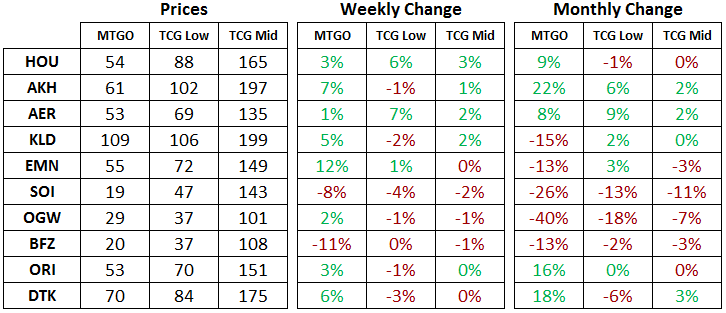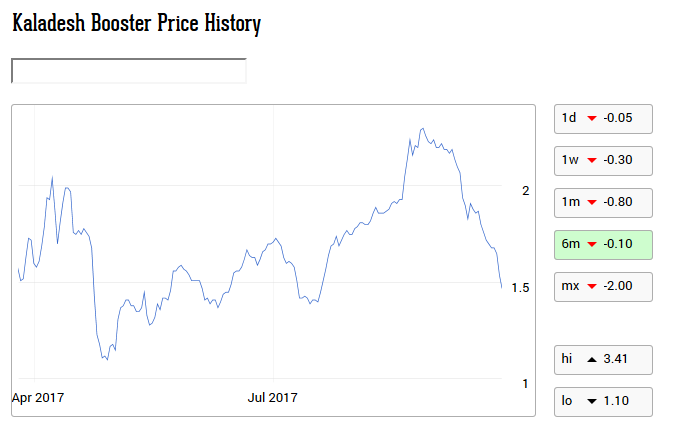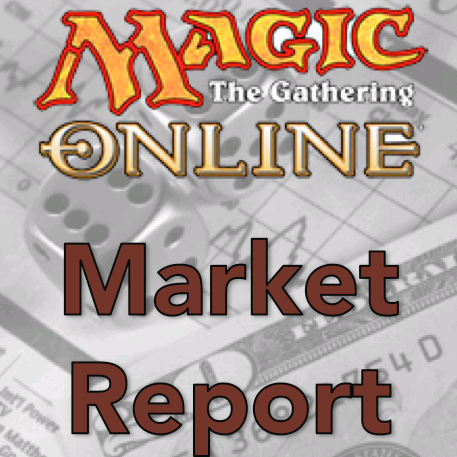Are you a Quiet Speculation member?
If not, now is a perfect time to join up! Our powerful tools, breaking-news analysis, and exclusive Discord channel will make sure you stay up to date and ahead of the curve.
Welcome to the MTGO Market Report as compiled by Matthew Lewis. The report will cover a range of topics, including a summary of set prices and price changes for redeemable sets, a look at the major trends in various Constructed formats and a "Trade of the Week" section that highlights a particular speculative strategy with an example and accompanying explanation.
As always, speculators should take into account their own budgets, risk tolerances and current portfolios before buying or selling any digital objects. Please send questions via private message or post below in the article comments.
Redemption
Below are the total set prices for all redeemable sets on MTGO. All prices are current as of September 25, 2017. The TCGplayer low and TCGplayer mid prices are the sum of each set's individual card prices on TCGplayer, either the low price or the mid price respectively.
All MTGO set prices this week are taken from GoatBot's website, and all weekly changes are now calculated relative to GoatBot's "full set" prices from the previous week. All monthly changes are also relative to the previous month's prices, taken from GoatBot's website at that time. Occasionally, full set prices are not available, and so estimated set prices are used instead. Although both Aether Revolt (AER) and Kaladesh (KLD) are no longer available for redemption, their prices will continue to be tracked while they are in Standard.

Standard
Ixalan (XLN) was released on Monday with an initial price of over 120 tix for a complete set and with Carnage Tyrant as the most expensive card at 18 tix. The most expensive rare was Growing Rites of Itlimoc at 14 tix, but that didn't last, as this card's price has plummeted all the way down to 2.6 tix. This type of volatility is completely normal for a new set as the market goes through the process of price discovery.
Novice speculators should steer clear of XLN for the moment, as there is very little economic advantage to be had in speculating on cards from the newest set. With a flood of supply coming in from Draft and Sealed Leagues, any speculative position is going to be hard to maintain for very long. Prices will inevitably come down for all the new cards, and particularly so for cards that aren't seeing any Standard play.
This is not a time for picking a pet card from XLN to speculate on; one will need a clear signal or testing data to verify that a card is underpriced and due for a price jump. With no economic advantage, I will be steering clear of stock picking from the new set for the time being. The only buys I would make would be to get a play set of foil mythic rares into my collection, which is guaranteed to at least preserve its value. For more on the foil mythic rare strategy and why it works, read up on it here.
On the mover and shake front, The Scarab God was sold out on GoatBots early Tuesday morning with a buy price of 20 tix. MTGOtraders had only four in stock in their online store, with a sell price of 20.68 tix. It looks like the best card in HOU is on its way to 25 tix at least. Once decklists from Standard leagues start rolling in, a clearer picture of the online metagame will form. Verdurous Gearhulk and Blooming Marsh are two other cards that have seen some buying pressure in the past two days.
Modern
XLN's release also heralds the rotation of Battle for Zendikar (BFZ), Oath of the Gatewatch (OGW), Shadows over Innistrad (SOI), and Eldritch Moon (EMN). All of these sets represent good value at the moment. After players and dealers alike turn their eyes to Modern this winter, the paper prices of these sets will stabilize and redeemers will start draining supply from MTGO. It's difficult to predict which sets will see the most gains, but both SOI and EMN have higher TCGplayer mid prices due to not having a Masterpiece series. Relative to the TCGplayer mid price, SOI is the cheapest of the four sets, though a relative lack of Modern staples might mean it's cheap for a reason.
Standard Boosters and Treasure Chests
AKH and HOU boosters went on sale on the Monday morning of XLN's MTGO release. A draft set was 6.1 tix when I checked the price originally, though by Tuesday morning the price had declined even further, hitting as low as 5.6 tix. A price of 6 tix or below is an excellent price to be a buyer, and I have added AKH block draft sets into the portfolio this week. This is a classic case of players getting rid of their extra boosters in order to draft with the new set. This type of short-term thinking is easy to profit off of for the patient speculator.
Consider that the tix-only entry fee for a draft is set at 12 tix. This means that entering an AKH block draft queue using secondary market boosters carries a substantial discount at the moment. As long as you can buy a draft set for less than 10 tix, players have an economic incentive to use the secondary market for draft entry. The current price of 6.0 tix for a draft set means that the total entry cost of boosters plus 2 tix is 8 tix, a 33-percent discount on the tix only entry fee.
Although there will be very little interest in AKH block draft in the next month, eventually there will be bargain hunters and players who just love AKH block draft who will be entering this draft queue again. With cheap draft sets available on the secondary market, players will have an economic incentive to buy these boosters to draft with. This will gradually push up the price over time. For speculators to benefit from this, all they have to do is to give up their tix today for these boosters and with a little patience, the tix you give up today will turn into 8 to 9 tix by the end of January. Players who love to draft AKH block should also take advantage of current prices in order to sock a few cheap draft sets away for the winter.
The news is not so good for AER and KLD boosters. There are no longer draft queues to support this format, so the utility from being able to draft with these boosters has been eliminated. As a result, they have started falling in price. Only the expected value (EV) of the booster contents will now provide price support.
Speaking of EV, the reshuffling of the Treasure Chest contents boosted their EV substantially between Sunday and Monday. For more on these changes, check out Chas Andres' analysis at the MTGOtraders YouTube channel. The price has responded since Monday, but the it's still below the EV as calculated by GoatBots. If there's a big reshuffling of the Treasure Chests contents in the future, it will be good to keep in mind the price action observed this week as a potential speculative strategy.
Trade of the Week
For a complete look at my recent trades, please check out the portfolio. With AKH and HOU boosters on sale, it's an easy strategy to buy these today in order to grind some tix over the next six months. All it takes is the legwork to buy and sell the boosters and the willingness to sink tix into a relatively unexciting spec.

For an idea of what to expect, KLD boosters went from 1.1 tix to 2.2 tix by the end of September, a 100-percent increase, while AER boosters went from 2.9 tix at the end of April to 3.6 tix in the same time frame, a 24-percent increase. In the portfolio, I managed to get a 25-percent return on 100 draft sets, after fees.

This time around, the price of draft set has fallen much lower. Whereas a KLD block draft set bottomed at 6.9 tix, two HOU boosters and one AKH booster has reached a total price of less than 6 tix. It's not clear to me yet how this lower price bottom will affect the end result. If a similar price peak of 9.4 tix is reached, then it will have yielded a gain of more than 50 percent. Speculators and players alike should rest assured though that this strategy is proven and has a strong economic angle to ensure a good result. As long as two HOU boosters and one AKH booster costs 7 tix or less, I will be a buyer this week.






Hey Matt, I was curious about what you pointed out in regards of AKH boosters finding a lower bottom relative to KLD. Could this be the expectation surrounding MTG Arena?
I think it would be really hard to identify exactly why this happened, but I am highly doubtful fear about the medium term possibility of Arena showing up could be the reason. Magic players just don’t think that long term about things, especially limited players. They draft, sell their cards, and then draft again.
I can’t really say what the reason is exactly. It’s possible that AKH block draft was more skill intensive than KLD block draft, and this resulted in better players winning more prizes. If more prizes are concentrated in the hands of the best players, they might be the ones selling more boosters into the secondary market, which results in the price dropping lower. That is just a guess though.